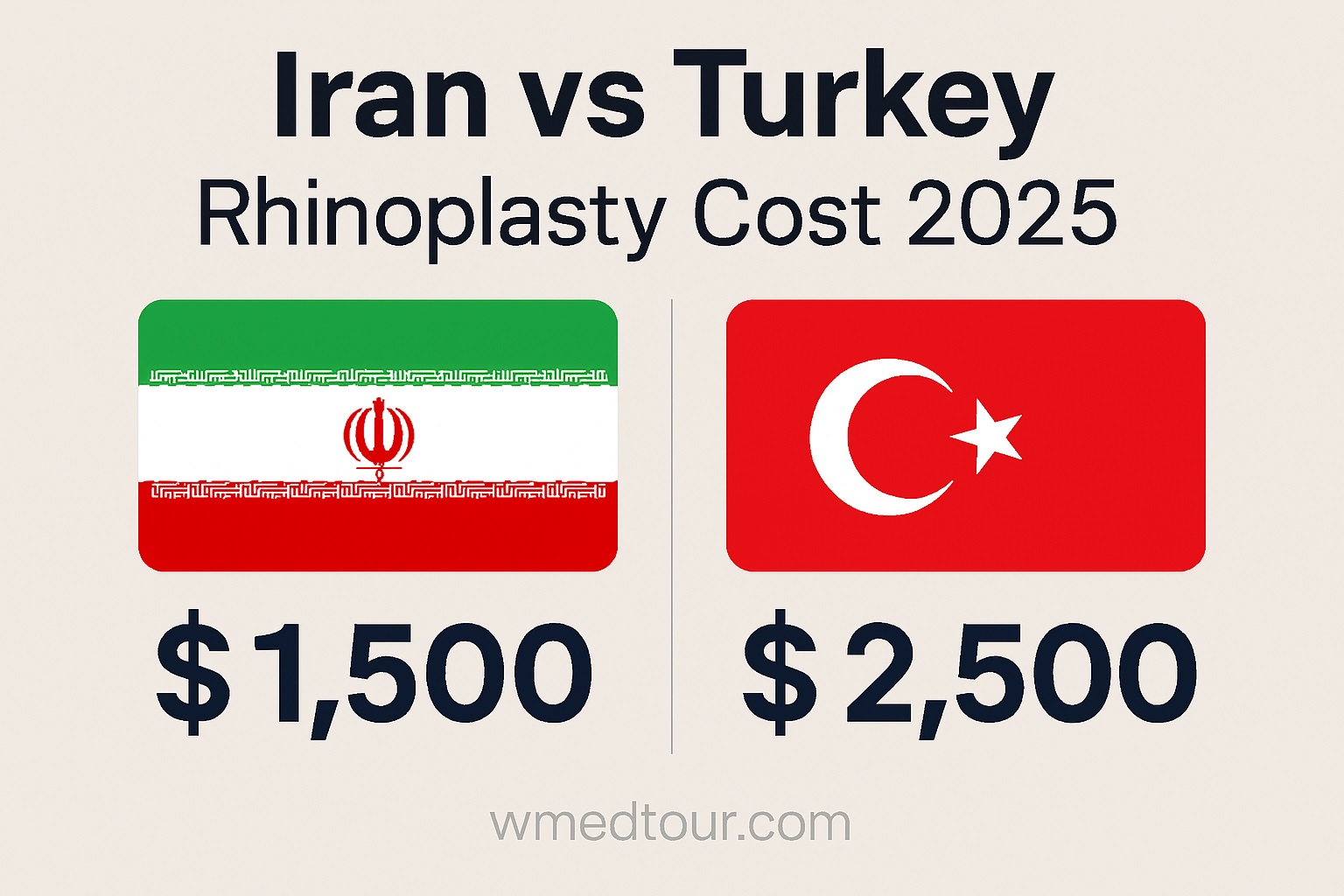Iran vs Turkey: Rhinoplasty Cost 2025 & Why It Matters
When you consider a nose job, also known as rhinoplasty, cost is undoubtedly one of the most critical factors. In 2025, two countries have emerged as global leaders in this medical field: Iran and Turkey. Both nations offer high-quality procedures at a fraction of Western prices, yet significant differences exist that prospective patients should recognize. This comprehensive guide will break down the intricacies of Iran vs Turkey rhinoplasty cost 2025, helping you make a well-informed decision that aligns with your budget and expectations. We’ll explore average nose job prices, what’s included in those costs, and other essential considerations for your medical journey. Ultimately, understanding these details is crucial for a successful experience.
An Overview of Rhinoplasty in Iran and Turkey
Rhinoplasty has become a massive industry in both Iran and Turkey, with each country carving out its own unique reputation. Surgeons in both nations perform a high volume of these procedures, which naturally leads to greater expertise. For instance, people widely recognize Iranian surgeons for their meticulous work on complex nasal structures, and they often cater to a wide range of aesthetic preferences. Likewise, Turkey’s medical tourism sector is robust, with state-of-the-art clinics and surgeons who have vast experience handling international patients. Furthermore, both countries’ governments actively support medical tourism, which contributes to competitive pricing and high standards. This thriving environment ensures that you can access some of the best surgical care available anywhere in the world. This thorough understanding of the financial breakdown is key to effective budgeting.
Understanding the Financial Breakdown
For many, the primary appeal of undergoing nose surgery in these destinations is affordability. In comparison to the United States, where a rhinoplasty can easily cost over $10,000, Iran and Turkey present a much more accessible option. The cost structure, however, is not always straightforward. Generally speaking, the total price includes the surgeon’s fee, anesthesia, hospital or clinic fees, and post-operative care. You must get a detailed quote to ensure you have no hidden costs. Furthermore, exchange rates and local economic conditions can influence the final cost, so it’s wise to stay updated on these factors. This thorough understanding of the financial breakdown is key to effective budgeting.
Rhinoplasty Cost 2025: Iran vs Turkey
| Factor | Iran | Turkey |
|---|---|---|
| Average Cost (USD) | $1,500 – $3,500 | $2,500 – $5,500 |
| Included Services | Surgeon, anesthesia, clinic fees, follow-up, sometimes hotel/transport | Surgeon, anesthesia, hospital fees, post-op, often includes all-inclusive packages (hotel, transport) |
| Geographical Focus | Tehran, Shiraz, Mashhad | Istanbul, Izmir, Antalya |
| Surgeon Experience | Highly specialized, high volume of cases | Vast experience with diverse clientele |
| Quality of Clinics | Modern, well-equipped hospitals & private clinics | JCI-accredited hospitals, high-tech facilities |
| Visa Requirements | Varies by nationality, often requires pre-application | Generally simpler visa process for many countries |
Why Is Iran More Affordable?
Several economic factors often make Iran the more budget-friendly option. For one thing, the currency exchange rate in Iran is highly favorable for those traveling with U.S. dollars or Euros, which dramatically reduces the total cost of services. In addition, the cost of living and operational expenses for clinics are lower in Iran compared to Turkey. This enables surgeons to offer their services at a more competitive price without compromising on quality. The world highly regards many Iranian surgeons, who possess extensive training and a passion for their craft. Therefore, the lower cost of rhinoplasty in Iran does not equate to a lower standard of care.
As a result, patients get top-tier surgical results for a price that few others can match globally. Moreover, many clinics offer comprehensive packages that include not only the surgery but also accommodation, transport, and a medical assistant. This kind of all-inclusive offering makes the entire process incredibly convenient and cost-effective. As you can see, the value proposition is quite strong, so it’s important to consider Iran as a primary option. This is a crucial point for anyone searching for “Iran vs Turkey rhinoplasty cost 2025.”
The All-Inclusive Packages of Turkey
On the other hand, Turkey has perfected the art of the all-inclusive medical tourism package. Many Turkish clinics provide everything a patient could need from the moment they land, including airport transfers, luxury hotel stays, and even city tours. This holistic approach makes the entire journey feel more like a vacation with a surgical component, rather than a clinical procedure. The prices, while higher than Iran’s, often reflect this added convenience and luxury.
For example, a package for a nose job in Istanbul might include a week’s stay at a five-star hotel, VIP transportation, and dedicated patient coordinators who speak multiple languages. Furthermore, many Turkish hospitals hold prestigious JCI accreditation, which is a global gold standard for healthcare quality. This provides an added layer of assurance for patients who prioritize comfort and internationally recognized standards. Ultimately, the choice between these two countries often comes down to a preference for a more clinical and direct approach (Iran) versus a more luxurious and comprehensive one (Turkey).
Beyond the Price: Quality of Care and Expertise
While Iran vs Turkey rhinoplasty cost 2025 is a central point of comparison, it’s essential to look beyond the numbers. The quality of care and the expertise of the surgeons should always be the top priority. Both countries boast highly skilled surgeons, but their specializations can differ. People especially recognize Iranian surgeons for their experience with ethnic noses and complex revisions. Likewise, Turkish surgeons often handle a vast and varied international clientele, giving them broad experience with different facial structures and aesthetic goals.
Before you make a final decision, we always recommend you thoroughly research potential surgeons. Check their credentials, look at their before-and-after portfolios, and read patient testimonials. A good place to start is the American Society of Plastic Surgeons surgeon locator, or the International Society of Aesthetic Plastic Surgery (ISAPS) database. A virtual consultation can also provide a personalized assessment and help you feel more confident about your choice.
Recovery and Post-Operative Care
The journey doesn’t end with the surgery itself; the recovery period is just as vital. Post-operative care in both Iran and Turkey is generally excellent, with clinics providing detailed instructions and follow-up appointments. In Turkey, the all-inclusive packages typically include a dedicated patient coordinator who will assist with all post-op needs, from dressing changes to medication reminders. In Iran, clinics also offer comprehensive follow-up care, and patients can easily communicate with their surgeon through a medical assistant.
For instance, a patient might stay for a week or more to ensure a smooth recovery before flying home. You must follow all post-operative instructions carefully to achieve the best results. Moreover, knowing that you have access to a support system during this time can greatly reduce stress. This consistent care helps to ensure that the patient experience is as seamless and comfortable as possible.
Navigating the Journey: A Step-by-Step Guide
Embarking on a medical trip requires careful planning. First, you should start by researching surgeons and clinics. After selecting a few candidates, schedule virtual consultations to discuss your goals and get a personalized quote. Subsequently, once you have made your choice, the clinic will guide you through the process of booking flights and preparing travel documents, including visa applications.
Many clinics will even help you secure your visa, which simplifies the process considerably. You will need to prepare for a stay of at least 7-10 days to allow for the surgery and initial recovery period. Finally, after your trip, most clinics offer remote follow-up consultations to monitor your progress. For more detailed information on a nose job in Iran, you can read our Rhinoplasty in Iran Cities Guide 2025.
Conclusion
When you weigh Iran vs Turkey rhinoplasty cost 2025, the decision ultimately rests on your personal priorities. Iran offers a highly affordable option without sacrificing quality, making it an excellent choice for budget-conscious patients. Conversely, Turkey provides a more comprehensive, luxury-oriented experience at a slightly higher price point. In both cases, you gain access to world-class surgeons and advanced medical facilities.
Regardless of your choice, you must conduct thorough research. As a result, you will find a trusted medical partner who can help you achieve your desired aesthetic results. If you are ready to take the next step and explore your options, we invite you to reach out. Our team at wmedtour.com can provide a personalized consultation to guide you through the process.




